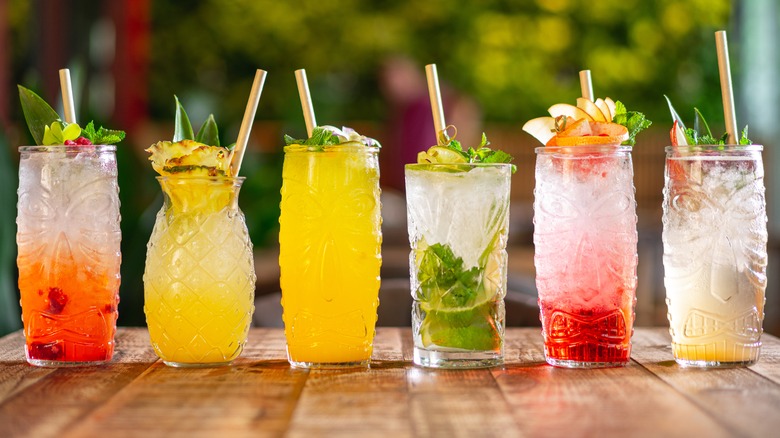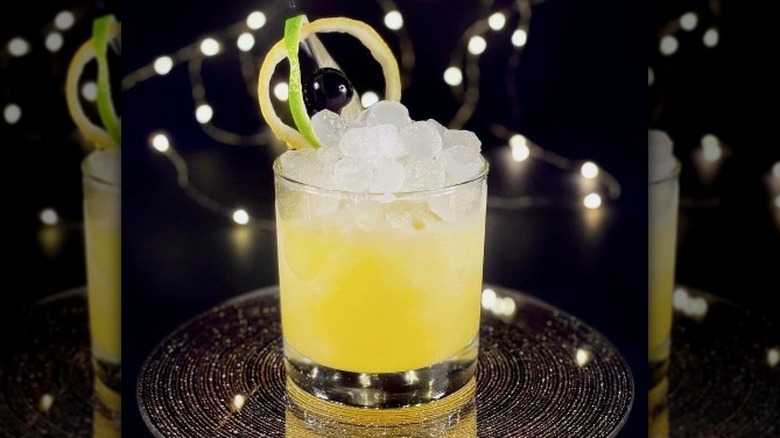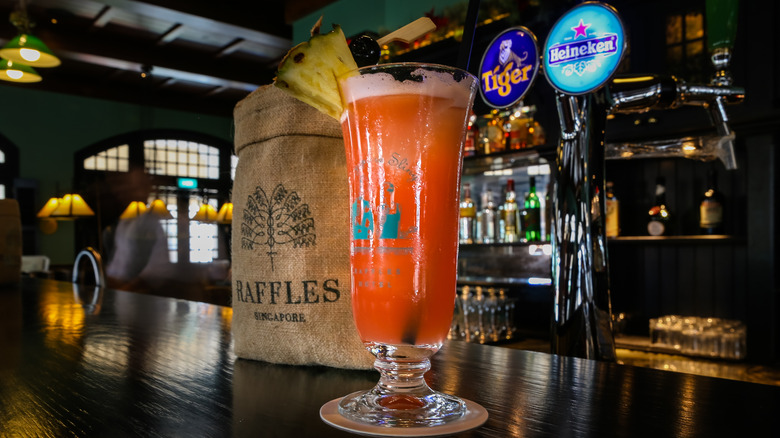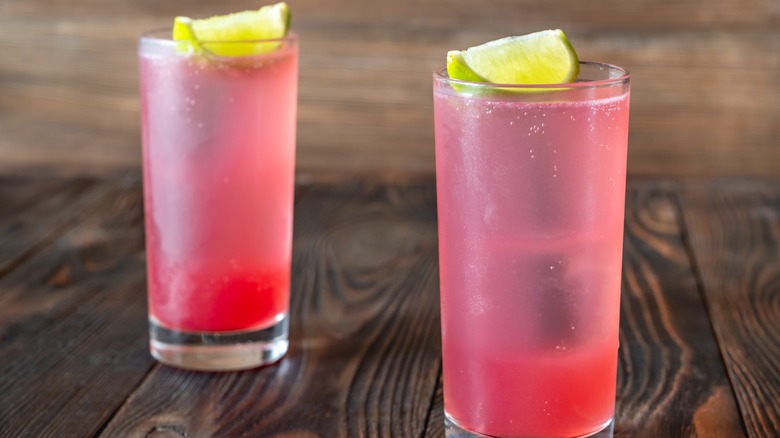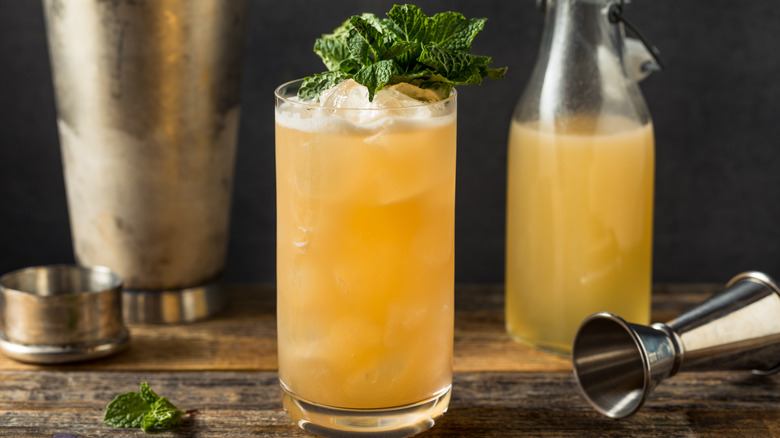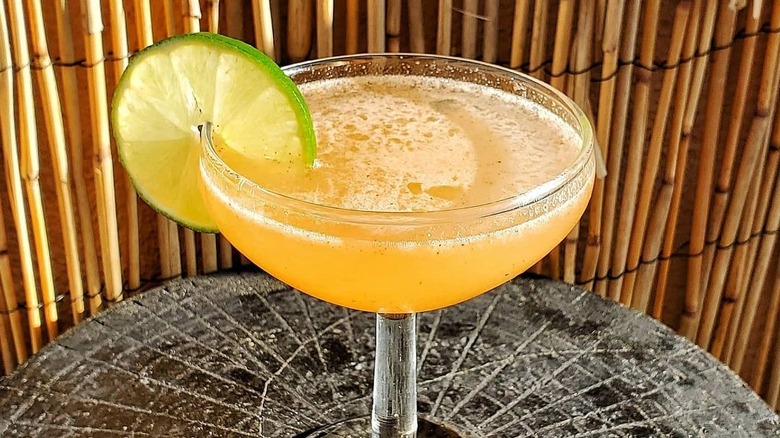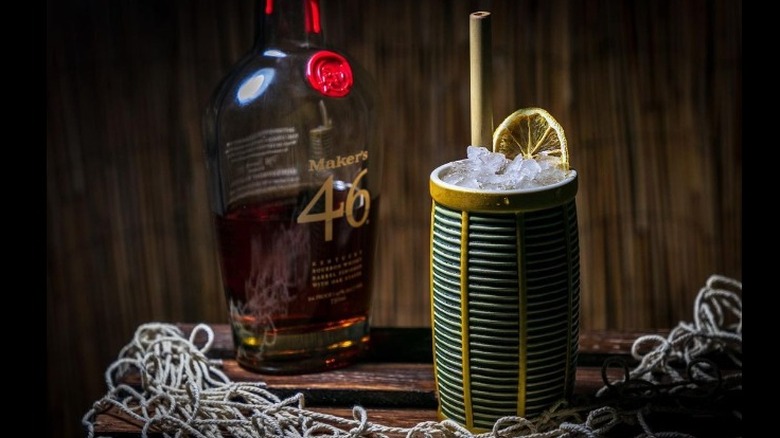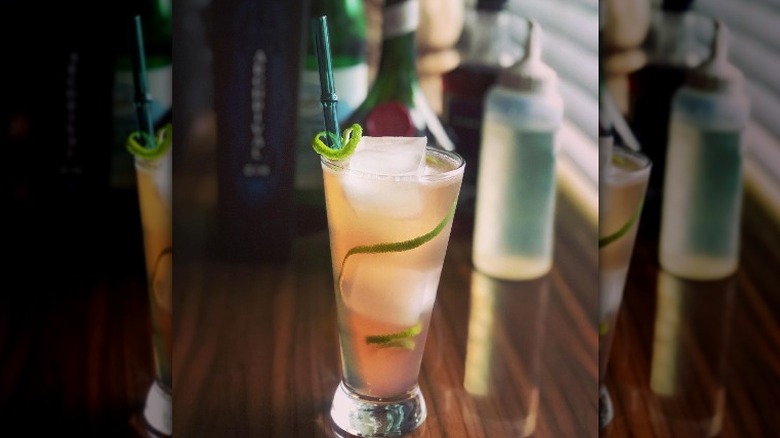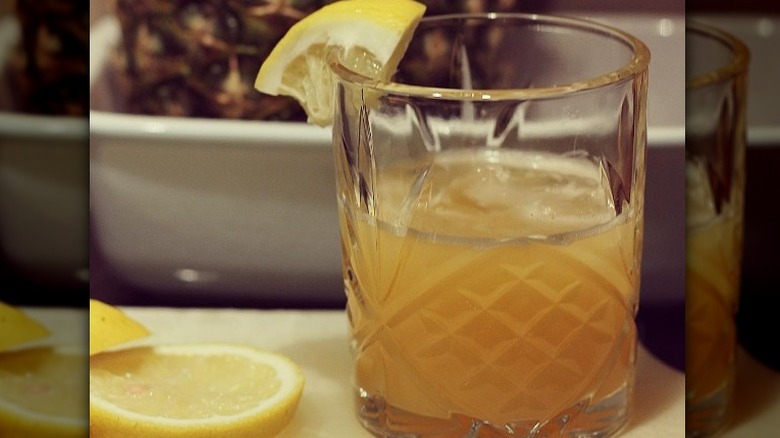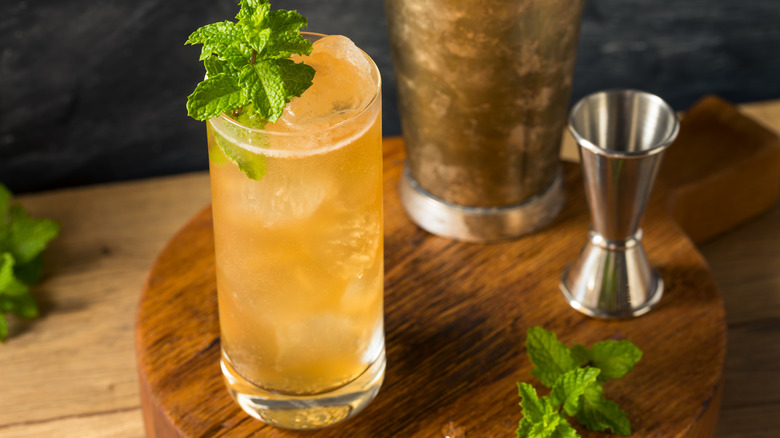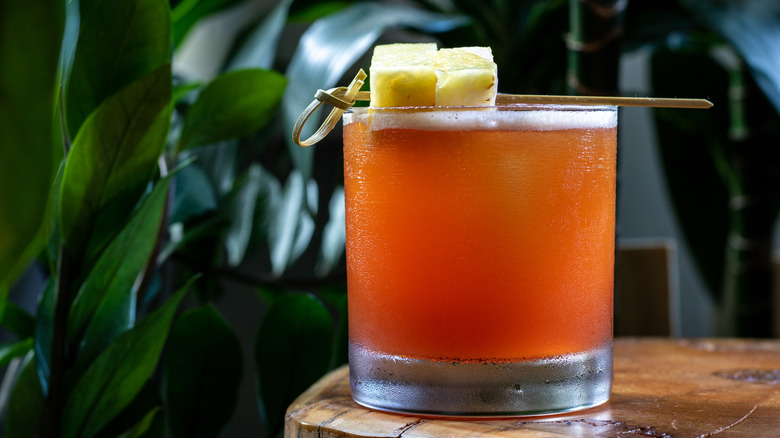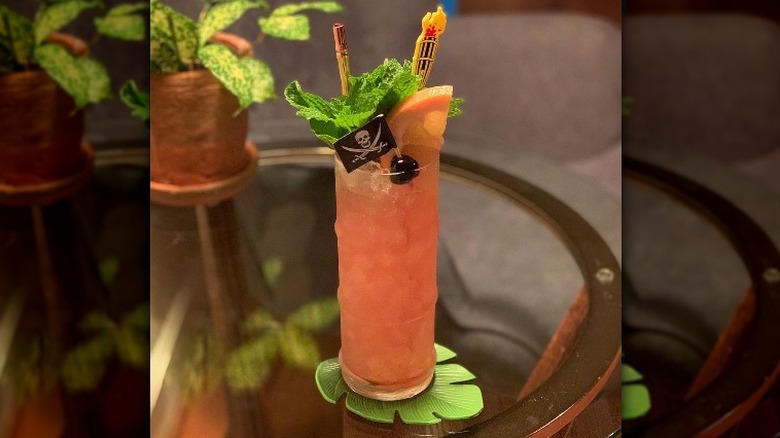11 Tiki Cocktails That Don't Use Rum
You might associate tiki with tropical romance, but the reason behind tiki's strong connection with rum isn't exactly romantic: Rum was cheap. Speaking with Imbibe, tiki entrepreneur Jeff "Beachbum" Berry said whiskey and gin were the spirits of choice in the early 20th century. Rum, on the other hand, was mostly for dirty sailors who go from port to port.
Rum's image got a shot in the arm when Prohibition hit. Looking to satiate well-heeled drinkers, bootleggers focused on making gins and whiskeys. Unfortunately, many of these products were dubious fakes that were dangerous to drink. Rum was considered safer because it was mostly smuggled in from established distilleries in the Caribbean. That switch in perception and the affordability of rum were big reasons mid-century tiki bartenders wholeheartedly embraced the sugarcane spirit.
Tiki really took off in post-war America. Veterans coming back from fighting in the Pacific found tropical ingredients and culture more relatable than before they left. As tiki transitioned from being a niche concept to mainstream culture, many people coming to tiki bars weren't necessarily fans of rum. So, tiki bartenders responded by developing more drinks made with gin, whiskey, and vodka. Tiki has gotten a lot more sophisticated since then, and the modern tiki canon is filled with all manner of non-rum drinks. We've compiled a list of them below.
The Saturn
Developed by bartender J. "PoPo" Galsini for the International Bartender's Association World Championship in 1967, The Saturn is one of those cocktails brought back from the dead by the recent craft cocktail revival, (via Vintage American Cocktails). After tiki fell out of favor, The Saturn largely languished in obscurity until it appeared in the 2010 book "Beachbum Berry Remixed." Now, just about every modern tiki bar worth its salt has the drink on its cocktail menu.
It's easy to see why The Saturn was brought back. Except for rum, it has all the ingredients of a classic tiki drink: passion fruit juice, orgeat syrup, and falernum. The original was blended, but many places will offer it as a shaken drink. Either way you order it, the true appeal of The Saturn is its garnish. A toothpick is used to hold together a ring of lemon peel and suspend a cocktail cherry in the center, creating a miniature ringed planet.
Singapore Sling
Necessity is the mother of invention, and sometimes, you just need a drink. In early 20th-century Singapore, women weren't supposed to drink alcohol in public. The Singapore Sling was created in 1917 at the Raffles Hotel in Singapore as a way for women to skirt the rules. Bartender Ngiam Tong Boon devised a drink meant to look like socially acceptable fruit juice, making it with a clear alcohol and camouflaging it further with the pink tint of grenadine.
Needless to say, the Singapore Sling has endured, and not just as a low-key drink for discreet ladies. It was prominently featured in Hunter S. Thompson's iconic novel "Fear and Loathing in Las Vegas." Tom Waits also sang about talking "baseball with a lieutenant over a Singapore Sling" in his song "Shoreleave." In 2015, Sipsmith Gin celebrated the 100th anniversary of the Singapore Sling by debuting a bespoke gin the distillery created in partnership with the Raffles Hotel. The gin included botanicals thought to have been in the region a century ago, such as jasmine flowers, lemongrass, and Kaffir lime leaf.
El Diablo
Made with tequila, ginger beer, and crème de cassis, the El Diablo cocktail presents a case study of why some old cocktails are having a second life, while others are not. El Diablo is having a moment right now because of the rise of agave spirits, specifically tequila and mezcal. But unlike, say, Tequila Sunrise, El Diablo is a bit of a blank slate — having escaped the dark cocktail days of the late 20th century.
According to Vinepair, El Diablo was spawned at the iconic Trader Vic's restaurant in the 1940s, and it appeared in Trader Vic's cocktail book that was published in 1946. Through the 50s and 60s, it mostly stayed within the domain of Trader Vic's and a handful of cocktail manuals.
Those old cocktail manuals became the subject of much fascination in the early 2000s, and El Diablo reappeared in craft cocktail menus around this time. However, the drink didn't catch fire until cocktail tastemakers shifted more their focus toward tequila and mezcal. Naturally, the modern craft cocktail versions of El Diablo emphasize fresh ingredients, typically substituting ginger syrup and soda for ginger beer.
Fog Cutter
After visiting Don's Beachcomber Café, the original tiki bar, in 1937, Vic Bergeron rebranded his own bar from Hinky Drinks to Trader Vic's, completely embracing Don's aesthetic in the process. Bergeron would put his own spin on some of Don's drinks, and some became even more popular than the originals. Based on the QB Cooler cocktail, Bergeron's Mai Tai is arguably his most iconic contribution to tiki, (via Distinguished Spirits on YouTube).
Although it's not as popular (yet) as the iconic Mai Tai, the Fog Cutter is said to have been Trader Vic's second-greatest cocktail invention. More importantly for Bergeron's legacy, it's an original creation that separates him from his tiki teacher by avoiding the use of rum, hence its inclusion on this list. More tart than most tiki drinks, The Fog Cutter has stood the test of time and it's being embraced by this generation of modern tiki bartenders.
Rangoon Gimlet
Made with the addition of Angostura bitters and green cocktail cherry, the Rangoon Gimlet is a spin on the traditional gimlet that was created in the early 1960s at the China Trader in California. The Rangoon Gimlet was developed by Tony Ramos, one of many Filipino bartenders that helped create the tiki aesthetic.
When the original tiki bar Don's Beachcomber Café opened in 1934, it featured an overwhelmingly Filipino bartending staff, (via Punch). Don's famously became a massive incubator for all things tiki, from the drinks to the aesthetic. Driving the success of Don's were four Filipino bartenders known as the Four Boys. While Ray Buhen is the only name of the Four Boys that hasn't been lost to history, these largely unsung bartenders were known for developing many of the drinks at Don's. Over the years, Filipino bartenders at Don's would go on to drive the success of tiki outposts that opened across the United States throughout the post-war period.
The Port Light
Combining bourbon and passionfruit, The Port Light is Exhibit A for the possibilities of non-rum spirits in tiki. Despite its use of bourbon instead of rum, The Port Light is probably more interesting for its place of origin: the Kahiki supper club in Columbus, Ohio. Built with a curved roof that resembled a Polynesian rowboat, and with massive flaming Maoi Heads guarding the front door, the Kahiki cost more than $1 million to build in 1960, (via Columbus Underground). Despite being placed on the National Register of Historic Places in 1997, the building was bought by Walgreens in 2000 and unceremoniously torn down.
Although the Kahiki is no more, its legacy lives on in the form of the Port Light cocktail. Trader Vic's adopted the cocktail a few decades ago and began serving it in a signature tumbler made to look like a boat's red port light. If you're looking to make your own Port Light cocktail, you can pick up a signature tumbler from Trader Vic's online store.
Oahu Gin Sling
Playboy magazine was famously known for having great articles, including articles for the aspiring home bartender. Thomas Mario was Playboy's food and drink editor for more than 30 years, and he's credited with developing the Oahu Gin Sling — a salacious mix of gin, Bénédictine, crème de cassis, and lime juice, (via "Beachbum Berry Remixed"). Mario published the cocktail right around the time he released his magnum opus: "Playboy's Host & Bar Book," which contained more than 700 recipes, (via Punch). In the book, Mario mused that bartending should be "part of every man's liberal education."
The Oahu Gin sling comes from the sling family of drinks. Made with liquor, sweetener, and later, citrus — slings actually predate cocktails, and the latter could be considered a bitter variation on the sling. At one point in their early history, slings were served hot. This trend was reversed in the late 19th century, however, as the proliferation of ice-making machines made it easier to serve cold drinks.
Eastern Sour
If you were going to bars before the recent craft cocktail revolution, you probably drank a few whiskey sours that were made with delicious, straight-out-of-the-soda-gun sour mix. The whiskey sour become popular, as you may have guessed, before premade sour mixes. Consisting of only liquor and lemon, the first recipe for the cocktail appeared in 1862. Commercially produced sour mixes were used later to make the drinks faster to make, and more approachable.
No one would blame you if those tart hangover bombs put you off whiskey sours. If they did, might we suggest the Eastern Sour: a brighter and sweeter take on the classic cocktail. The Eastern Sour keeps the winning combination of whiskey (or bourbon) and lemon, but it adds orange juice and the almond-flavored syrup known as orgeat. The addition of those two ingredients makes the Eastern Sour sweeter, but if you like a drink that's more on the tart side, you can go a bit heavier with the lemon juice.
Suffering Bastard
Most cocktails come with a good story, but it's hard to top this one: Created in Egypt and used to defeat the Nazis, the Suffering Bastard is a tiki drink that's all vibes, no rum. Wait, let's back that up. When was a cocktail used to defeat Nazis?
In 1941, Joe Scialom was bartending at the swanky Shepeard's Hotel in Cairo, serving drinks to British soldiers battling Nazi forces commanded by Erwin Rommel — the Desert Fox himself. With the war effort making it hard to maintain a fully-stocked bar, Scialom concocted a drink made of bourbon, gin, lime juice, Angostura bitters, and ginger beer. The Suffering Bastard proved to be so popular, Scialom received a telegram from British soldiers at the Battle of El Alamein ordering 8 gallons of the stuff, (via Chambar). Naturally, the Nazis were drunkenly routed at El Alamein and Hitler's plan to capture the Suez Canal was in tatters. It was a major turning point in World War II and Winston Churchill famously said, "Before El Alamein, we never had a victory. After El Alamein, we never had a defeat," (via Drink Magazine).
After the war, the Suffering Bastard returned home with its brothers in arms, eventually becoming a staple in tiki bars. So the next time you raise a Suffering Bastard, be sure to thank it for its service.
Jungle Bird
As a tiki drink, the Jungle Bird stands out for its use of Campari. But the most polarizing ingredient in some Jungle Birds isn't the bitter Italian aperitif, it's blackstrap rum. First of all, "blackstrap" isn't an officially recognized category of rum. Second, many rums labeled blackstrap are industrially distilled and filled with additives. However, there are two sides to this debate. Advocates say blackstrap rum brings a maple-like sweetness that pairs well with the cocktail's citrus and bitter notes.
Perhaps because it included Campari, the Jungle Bird has found a home on many modern craft cocktail bar menus, which tend to fetishize bitter flavors. Some bars sidestep the blackstrap rum debate by using spirits other than rum. At Cindy's rooftop bar in Chicago, rum is replaced by cold-brew coffee and Amaro Meletti to create the Roman Holiday cocktail. Also in Chicago at the now-defunct Lost Lake, rum was replaced with tequila and mezcal to create the Surfin' Bird.
The Winchester
Rum is so entrenched in the tiki aesthetic, it takes something special for a non-rum drink to get noticed. So leave it to the cocktail masters at Death & Co to do just that with The Winchester — a brains-chomping Zombie riff that swaps gin for rum. According to Punch, Jeff "Beachbum" Berry called The Winchester the best 21st-century cocktail to expand the boundaries of tiki, while tiki authority Martin Cate called it "a hell of a good drink."
The classic Zombie recipe calls for three different kinds of rum: a Puerto Rican "white" rum, a Jamaican rum, and a high-octane overproof rum. For Death & Co, tiki iconoclast Brian Miller followed this template with three different gins to create The Winchester: London dry, Old Tom, and navy strength. St-Germain and ginger syrup are then added to the usual Zombie suspects of lime, grapefruit, and grenadine. The Winchester is proof that tiki is still evolving in the 21st century, but it's not the only proof. Miller has also created a tiki-influenced Old Fashioned called the Conference, made with bourbon, whiskey, rye, calvados, and two kinds of bitters.
